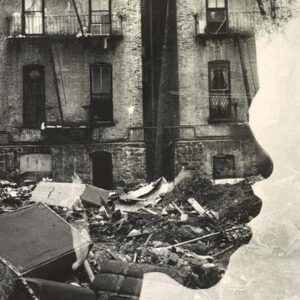
What Aging Can Teach Us About Creativity and Fulfillment
Philip Weinstein Explores Philosophical and Literary Approaches to the End of Life
“Death is the mother of beauty; hence from her,
Alone, shall come fulfilment to our dreams
And our desires.”
–Wallace Stevens, “Sunday Morning”
*Article continues after advertisement
These haunting lines by Wallace Stevens promise more than I have ever managed to understand about death: that it shall bring “fulfilment to our dreams / And our desires.” By contrast, the beauty I have come to discover in endgame scenarios has nothing to do with dreams and desires. Quite the opposite: it is rather that old age’s stark unfoldings—long dreaded as disabling, feared as surcease itself—may nevertheless carry a creative charge that you could not possibly imagine before arriving there. The kind of beauty that emerges is generated not by fulfilment, but rather by an opposing dynamic of change, exposure, the threat of collapse.
Put otherwise, becoming old—approaching death—opens onto unanticipated scenarios that are interesting. Not ethically satisfying—nothing enabling or “rewarding” is happening here—yet aesthetically compelling: emergent dramas that strike you with their undeniable cogency, their “rightness.” When the philosopher Friedrich Nietzsche claimed (in The Birth of Tragedy) that existence can be justified only on aesthetic grounds, he was acknowledging that other criteria for justifying life come up short.
Unmastered change is life’s keynote; with the final change we cease to exist. Though life may not ultimately come to mean anything, Nietzsche surmised, its passage generates remarkable beauty along the way—and in special ways as the end approaches. In fact, however macabre this sounds, our journey toward extinction throbs with interest. Nietzsche imagines the enjoyment the gods might derive from observing the human comedy; life’s last chapters exert a bizarre attraction all their own. These are some of the wintry dramas I seek to shed light on.
Old age involves our passage from an unthinking resourcefulness…to a speculative space where nothing can be taken for granted.
A distinction associated with another philosopher, Martin Heidegger, may provide further guidance. Though Heidegger can be notoriously difficult, his distinctions sometimes simply hit home. The one I have in mind is the distinction between objects unthinkingly available for use—what he calls the “ready-to-hand”—and objects that have ceased to be useful and have become what he calls the “present-at-hand.” Heidegger himself relishes the resourcefulness of our “ready-to-hand” world. His focus is on our ongoing deployment of a furnished and to-be-acted-upon world—on how we go about, moment by moment, making our world work for us. Which is great: until it stops. That is the point at which what is “ready-to-hand” becomes—oddly, suddenly—merely “present-at-hand.” Just there.
In so doing, it announces one of old age’s compelling dramas: the drama of no longer being able to make things work. Yet this is precisely the moment when the elements that have long made up our ambient world (ultimately: our body itself) may become luminous—as only elements shorn of their previous functionality can become luminous. Old age involves our passage from an unthinking resourcefulness (where we just continue to “get on with it”) to a speculative space where nothing can be taken for granted: a space of recurrent radiance.
The role of death as generator of human values is well known. A bedrock reason we care for others is our half-repressed lifelong awareness that neither we nor they will be here forever. Time’s passage creates human value in the wake of its positing losses to come. Our creativity is hardwired to our premonition, however muffled, that we will eventually cease to be.
But death’s approach generates, as well, a less familiar set of dramas. Involving the beset and failing will, these differ from the projects of our earlier years. Those projects—typically centering on maturation, courtship, family, work, career—focused on becoming. As Nietzsche put it in another context, each of them was “pregnant with a future.” It would be hard not to think of our ongoing life as a narrative composed of challenges encountered and taken on—with rewards (of one form or another) anticipated in the offing. This is a developmental narrative of coming through the storm and finding ourselves renewed. Versions of this story underwrite most of the novels that we read, the movies that we see. However variable the form of this story, its motor is the individual will. Its bedrock premise is a recovered capacity that follows initial setbacks.
Who we were, who we are, and who we will be: these are condemned to remain…strangers to each other.
But think instead of the dinner party where you hear of the trip gone irreparably wrong because of COVID, the stroke that suddenly occurred, the cancer just diagnosed, the onset of Alzheimer’s. These stories center on bodies no longer doing the bidding of the will, on minds going gamey as well. Whatever beauty obtains here has little to do with a pregnant future. We already know what future awaits. To take a lesser example: think of old people walking, trying not to fall even as they know that eventually they will slip up and fall. If you ask, when did walking take on the interest of a (modest, daily) drama, the answer is that—as with Heidegger’s faulty hammer that compels attention only when it ceases to work—walking compels attention when it ceases to be an unthinking capacity.
When it reconfigures as a potentially troublesome activity, requiring care. No longer the automatic moves one makes en route toward somewhere else, walking becomes uncertain as such, an activity newly fraught with risk. Its interest resides not in getting something accomplished, but rather in our newly mandated thinking about ourselves as figures caught out in unmastered motion—and heading toward the fall. What could differ more from the will-directed shaping of a self, the coordination of resources in the pursuit of a goal?
These ominous little dramas generate new forms of thought and feeling all their own. When I spoke to a friend of mine (and close to my age) about the strange thoughts that our bodily infirmities give rise to, he recalled one of John Updike’s late stories. There the narrator muses on “the Big Guy” who now has us older folks in his sights. In Updike’s scenario, as in ours, we have exited from the role of the subject-who-does and entered the role of the object-of-Someone’s-gaze—we find ourselves in His sights and power. Rather than doer, we are potentially done to, found faulty, at risk of being whisked away. Think as well of old people’s burgeoning entourage of doctors—an entourage that bespeaks their incapacity to “do it alone” anymore. Even their two legs—on which they used to delight in “doing it alone”—start to require the supplement of a cane.
Oedipus’s capacity to think along these lines famously allowed him to solve the riddle of the Sphinx. When asked “what creature walks on four legs in the morning, two legs at noon, and three legs in the evening,” only Oedipus had the insight to answer “man.” For Oedipus to envisage (while on two legs as an adult) the “four legs” (two plus two arms) he once traveled on as an infant, as well as the “three legs” (two plus a cane) he will travel on late in life is a radiant insight. Yet it is blinding as well, for the riddle that yields to Oedipus’s abstract thought is irresistibly reconstituted over time’s passage. And reconstituted at Oedipus’s expense. Decode it though he may, he cannot coordinate the trinity of different times that the riddle encompasses. No one can.
Who we were, who we are, and who we will be: these are condemned to remain—despite Oedipus’s conceptual grasp of all three—strangers to each other. As Marcel Proust puts it in his great novel In Search of Lost Time, we become ourselves only sequentially, over time (on ne se réalise que successivement). We move through time in single file, so to speak—avatar by avatar. We do not cumulatively bestride it. Yet, though I can never experience childhood again, I sense that I am approaching that third leg, the time of the cane. I glimpse it coming my way.
__________________________________

From Time’s Bounty: Rethinking Aging by Philip Weinstein. Copyright © 2025 by Philip Weinstein. Available from David R. Godine Publisher. Reprinted with permission of the publisher.
Philip Weinstein
Philip Weinstein, for over forty years, was professor of English at Swarthmore College, and during that time published nine books of literary criticism. His Becoming Faulkner won the Hugh Holman Award as the best book on Southern Literature published in 2010. His recent essay, “Soul-Error,” was chosen for inclusion in Best American Essays 2020.



















